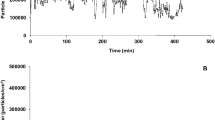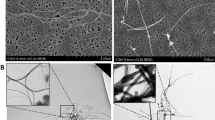Abstract
Potential efficacy of zileuton, a 5-LOX inhibitor, was evaluated for the reduction of pulmonary adenomas in the A/J murine model when administered via nose-only inhalation. Development of pulmonary adenomas was induced with benzo(a)pyrene. Animals were treated with a zileuton solution (5 mg/mL in 85:15 ethanol/water) either twice weekly or five times a week via nose-only inhalation; The placebo solution (85:15 EtOH/H2O, no active) was also evaluated. Dose delivered was calculated to be 1.2 mg/kg per exposure for each zileuton group. After 20 weeks of treatment, surface tumors were enumerated and histologically assessed. A significant reduction in tumor count was noted for both the twice weekly administration (40%) and the five times a week administration (59%). The data also showed a significant reduction for the group, which received the placebo (approximately 58%). The treatment groups were also found to have an impact on the histological stages of adenoma development.




Similar content being viewed by others
References
American Cancer Society. Cancer Reference Information [Internet]. c2009 [cited 2009 Jun 8]. http://www.cancer.org/docroot/CRI/content.
Gupta PK. Drug targeting in cancer chemotherapy: a clinical perspective. J Pharm Sci. 1990;79(11):949–62.
Gagnadoux F, Hureaux J, Vecellio L, Urban T, Le Pape A, Valo I, et al. Aerosolized chemotherapy. J Aerosol Med. 2008;21(1):1–9.
Rioux N, Castonguay A. Inhibitors of lipoxygenase: a new class of cancer chemopreventives agents. Carcinogenesis. 1998;19(8):1393–400.
Steele VE, Holmes CA, Hawk ET, Kopelovich L, Lubert RA, Crowell JA, et al. Lipoxygenase inhibitors as potential cancer chemopreventives. Cancer Epidemiol Biomarkers Prev. 1999;8(5):467–83.
Steele VE, Holmes CA, Hawk ET, Kopelovich L, Lubert RA, Crowell JA, et al. Potential use of lipoxygenase inhibitors for cancer chemoprevention. Exp Opin Invest Drugs. 2000;9:2121–38.
Moody TW, Leyton J, Martinez A, Hong S, Malkinson A, Mulshine JL. Lipoxygenase inhibitors prevent lung carcinogenesis and inhibit non-small cell cancer growth. Exp Lung Res. 1998;24:617–62.
Avis IM, Jett M, Boyle T, Vos MD, Moody T, Treston AM, et al. Growth control of lung cancer by interruption of 5-lipoxygenase-mediated growth factor signaling. J Clin Inv. 1996;97(3):806–13.
Bell RL, Young PR, Albert D, Lanni C, Summers JB, Brooks DW, et al. The discovery and development of Zileuton: an orally active 5-lipoxygenase inhibitor. Int J Immunopharmac. 1992;14(3):505–10.
Carter GW, Young PR, Albert DH, Bouska J, Dyer R, Bell RL, et al. 5-Lipoxygenase inhibitory activity of Zileuton. J Pharm Exp Thera. 1991;256(3):929–37.
Gunning WT, Kramer PM, Steele VE, Pereira MA. Chemoprevention by lipoxygenase and leukotriene pathway inhibitors of vinyl carbamate-induced lung tumors in mice. Cancer Res. 2002;62:4199–201.
Myrdal PB, Karlage K, Kuehl PJ, Angersbach BS, Merrill BA, Wightman PD. Effects of novel 5-lipoxygenase inhibitors on the incidence of pulmonary adenomas in the A/J murine model when administered via nose only inhalation. Carcinogenesis. 2007;28(5):957–61.
Estensen RD, Jordan MM, Wiedmann TS, Galbraith AR, Steele VE, Wattenberg LW. Effect of chemopreventive agents on separate stages of progression of benzo(a)pyrene induced lung tumors in A/J mice. Carcinogenesis. 2004;25(2):197–201.
Stein SW, Myrdal PB, Gabrio BJ, Obereit D, Beck TJ. Evaluation of a new aerodynamic particle sizer spectrometer for size distribution measurement of solution metered dose inhalers. J Aerosol Med. 2003;16(2):107–19.
Wattenberg LW, Wiedmann TS, Zimmerman CL, Galbraith AR, Steele VE, Kelloff GJ. Chemoprevention of pulmonary carcinogenesis by brief exposures to aerosolized budesonide or beclomethasone diproprionate and by the combination of aerosolized budesonide and dietary myo-inositol. Carcinogenesis. 2000;21:179–82.
Alexander DJ, Collins CJ, Coombs DW, Gilkison IS, Hardy CJ, Healey G, et al. Association of inhalation toxicologists (AIT) working party recommendation for standards delivered dose calculation and expression in non-clinical aerosol inhalation toxicology studies with pharmaceuticals. Inhal Toxicol. 2008;20:1179–89.
Foley JF, Anderson MW, Stoner GD, Gaul BW, Hardsity JF, Maronpot RR. Proliferative lesions of the mouse lung: progression studies in strain A mice. Exp Lung Res. 1991;17:157–68.
Dungworth DL, Rittinghausen S, Schwartz L, Harkema JR, Hayashi Y, Killel B, et al. Respiratory system and mesothelium. In: Mohr U, editor. International classification of rodent tumors: the mouse. Germany: Springer; 2001. p. 87–138.
Garro AJ, Lieber CS. Alcohol and cancer. Annu Rev Pharmacol Toxicol. 1990;30:219–49.
Seitz HK, Simanowski UA. Alcohol and carcinogenesis. Am Rev Nutr. 1988;8:99–119.
Yirmiya R, Ben-Eliyahu S, Gale RP, Shavit Y, Liebeskind JC, Taylor AN. Ethanol increases tumor progression in rats: possible involvement of natural killer cells. Brain Behav Immun. 1992;6:74–86.
Nachiappan V, Mufti SJ, Chakravarti A, Eskelson CD. Rajacekharan. Lipid peroxidation and ethanol-related tumor promotion in Fisher-344 rats treated with tobacco-specific nitrosamines. Alcohol Alcohol. 1994;29(5):565–74.
Wu W-J, Pruett SB. Ethanol decreases host resistance to pulmonary metastases in a mouse model: role of natural killer cells and ethanol-induced stress response. Int J Cancer. 1999;82:886–92.
Beland FA, Benson RW, Mellic PW, Kovatch RM, Roberts DW, Fang J-L, et al. Effect of ethanol on the tumorigenicity of urethane (ethyl carbamate) in B6C3F1 mice. Food Chem Toxicol. 2005;43:1–19.
Altmann H-J, Dusemond B, Goll M, Grunow W. Effect of ethanol on the induction of lung tumors by ethyl carbamate in mice. Toxicology. 2005;43:1–19.
Djousee L, Dorgan JF, Zhang Y, Schatzkin A, Hood M, D’Agostino RB, et al. Alcohol consumption and risk of lung cancer: the Framingham study. J Natl Cancer Inst. 2002;94(24):1877–82.
Zang EA, Wynder EL. Reevaluation of the confounding effect of cigarette smoking on the relationship between alcohol use and lung cancer risk with larynx cancer used as a positive control. Prev Med. 2001;32:359–70.
Dahl AR, Grossi IM, Houchens DP, Scovell LJ, Placek ME, Imondi AR, et al. Inhaled isotrenoin (13-cis retinoic acid) is an effective lung cancer chemopreventive agent in A/J mice at low doses: a pilot study. Clin Cancer Res. 2000;6:3015–24.
Stoewsand GS, Anderson JL, Munson L. The role of wine in ethyl carbamate induced carcinogenesis inhibition. ACS Symposium Series. 1997;661:220–36.
Kristiansen E, Clemmensen S, Meyer O. Chronic ethanol intake and reduction of lung tumors from urethane in strain A mice. Fd Chem Toxic. 1990;28(1):35–8.
Batkin S, Tabrah FL. Ethanol vapour modulation of Lewis lung carcinoma, a murine pulmonary tumour. J Cancer Res Clin Oncol. 1990;116:187–9.
Yum S, Lee E, Taskovich L, Theeuwes F. Permeation enhancement with ethanol: mechanism of action through the skin. Drugs Pharmaceut Sci. 1994;62:143–70.
Gupta A, Stein SW, Myrdal PB. Balancing ethanol cosolvent concentration with product performance in 134a-based pressurized metered dose inhalers. J Aerosol Med. 2003;16(2):167–74.
Acknowledgment
This research study was funded by the Arizona Biomedical Research Commission, Grant no. 5-082.
Author information
Authors and Affiliations
Corresponding author
Rights and permissions
About this article
Cite this article
Karlage, K.L., Mogalian, E., Jensen, A. et al. Inhalation of an Ethanol-Based Zileuton Formulation Provides a Reduction of Pulmonary Adenomas in the A/J Mouse Model. AAPS PharmSciTech 11, 168–173 (2010). https://doi.org/10.1208/s12249-009-9371-6
Received:
Accepted:
Published:
Issue Date:
DOI: https://doi.org/10.1208/s12249-009-9371-6




